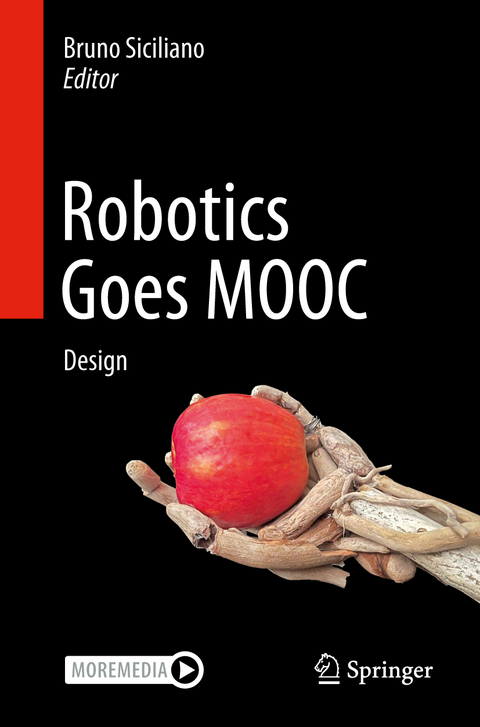
Robotics Goes MOOC
Springer International Publishing (Verlag)
978-3-319-75822-0 (ISBN)
- Noch nicht erschienen - erscheint am 09.02.2025
- Versandkostenfrei innerhalb Deutschlands
- Auch auf Rechnung
- Verfügbarkeit in der Filiale vor Ort prüfen
- Artikel merken
A robot's appearance and its way of interacting with humans is of fundamental importance. Until a few years ago there was a clear asymmetry between the typically excellent performance of industrial robots and their ugly and disharmonious bodies, with crude ways and potentially very dangerous movements
for the human environment. A modern artifact can be as harmonious and beautiful as a complex biological machine or a work of plastic art and thus it should be clear how design plays a key role for robot technology to become a part of our everyday life and change it essentially in a responsible and beneficial manner. It is designers who shape the interface between humans and machines and, as such, they will contribute to make robots as customizable and intuitively useful to inexperienced users according to a plug-and-play mode.
The new concept of robotronics as the mechatronics approach to designing advanced robots is the focus of the first chapter of the second book of the Robotics Goes MOOC project by Asfour et al. The main issues for robot manipulator design are covered in the subsequent material, namely redundant robots in Chapter 2 by Maciejewsky et al and parallel robots in Chapter 3 by Müller, where widely adopted kinematic solutions are presented. Then, the adoption to flexibilty, as opposed to the rigid mechanics paradigm, is discussed in Chapter 4 by Bertram et al with reference to elastic robots and in Chapter 5 by Laschi focused on soft robotics. Somewhat speculating on the previous two design solutions comes Chapter 6 by Cutkosky dealing with bioinspired robots. The last part of the book is devoted to robot locomotion, namely, Chapter 7 by Vendittelli on wheeled robots and Chapter 8 by Harada on (biped) humanoids.
Bruno Siciliano received his doctorate degree in Electronic Engineering from the University of Naples, Italy, in 1987. He is a professor of Control and Robotics at the University of Naples Federico II. His research focuses on methodologies and technologies in industrial and service robotics, including force and visual control, cooperative robots, human-robot interaction, and aerial manipulation. He has co-authored 6 books and over 300 journal papers, conference papers and book chapters. He has delivered more than 20 keynote presentations and over 100 colloquia and seminars at institutions around the world. He is a fellow of IEEE, ASME and IFAC, and co-editor of the Springer Tracts in Advanced Robotics (STAR) series and the Springer Handbook of Robotics, which received the PROSE Award for Excellence in Physical Sciences & Mathematics and was also the winner in the category Engineering & Technology. He has served on the editorial boards of prestigious journals, as well as chair or co-chair for numerous international conferences. Professor Siciliano is the past president of the IEEE Robotics and Automation Society (RAS). He has been the recipient of several awards, including the IEEE RAS George Saridis Leadership Award in Robotics and Automation and the IEEE RAS Distinguished Service Award.
1 Tamim Asfour, Samuel Rader, Pascal Weiner, Felix Hundhausen, Julia Starke, Cornelius Klas, Stefan Reither, Chrisfian R. G. Dreher, Fabian Reister, Miha Dezman and Charlofte Marquardt, Robotronics - Robot Mechatronics.- 2 Anthony A. Maciejewski and Biyun Xie, Redundant Robots.- 3 Andreas Müller, Parallel Robots.- 4 Joern Malzahn, Freia Muster and Torsen Bertram, Elastic Robots.- 5 Cecilia Laschi, Soft Robots.- 6 Mark R. Cutkosky, Bioinspired Robot Design.- 7 Marilena Vendittelli, Wheeled Robots.- 8 Kensuke Harada, Humanoids.
| Erscheinungsdatum | 03.12.2023 |
|---|---|
| Zusatzinfo | X, 190 p. 169 illus., 97 illus. in color. |
| Verlagsort | Cham |
| Sprache | englisch |
| Maße | 155 x 235 mm |
| Themenwelt | Technik ► Elektrotechnik / Energietechnik |
| Schlagworte | Design • Impact • interaction • Knowledge • Moocs • Robotics |
| ISBN-10 | 3-319-75822-5 / 3319758225 |
| ISBN-13 | 978-3-319-75822-0 / 9783319758220 |
| Zustand | Neuware |
| Haben Sie eine Frage zum Produkt? |
aus dem Bereich


